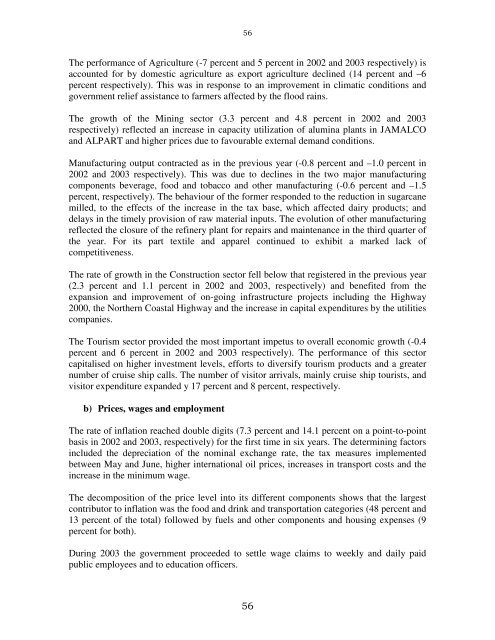Jamaica: Macro-Socio-Economic and Environmental Assessment of ...
Jamaica: Macro-Socio-Economic and Environmental Assessment of ...
Jamaica: Macro-Socio-Economic and Environmental Assessment of ...
You also want an ePaper? Increase the reach of your titles
YUMPU automatically turns print PDFs into web optimized ePapers that Google loves.
56<br />
The performance <strong>of</strong> Agriculture (-7 percent <strong>and</strong> 5 percent in 2002 <strong>and</strong> 2003 respectively) is<br />
accounted for by domestic agriculture as export agriculture declined (14 percent <strong>and</strong> –6<br />
percent respectively). This was in response to an improvement in climatic conditions <strong>and</strong><br />
government relief assistance to farmers affected by the flood rains.<br />
The growth <strong>of</strong> the Mining sector (3.3 percent <strong>and</strong> 4.8 percent in 2002 <strong>and</strong> 2003<br />
respectively) reflected an increase in capacity utilization <strong>of</strong> alumina plants in JAMALCO<br />
<strong>and</strong> ALPART <strong>and</strong> higher prices due to favourable external dem<strong>and</strong> conditions.<br />
Manufacturing output contracted as in the previous year (-0.8 percent <strong>and</strong> –1.0 percent in<br />
2002 <strong>and</strong> 2003 respectively). This was due to declines in the two major manufacturing<br />
components beverage, food <strong>and</strong> tobacco <strong>and</strong> other manufacturing (-0.6 percent <strong>and</strong> –1.5<br />
percent, respectively). The behaviour <strong>of</strong> the former responded to the reduction in sugarcane<br />
milled, to the effects <strong>of</strong> the increase in the tax base, which affected dairy products; <strong>and</strong><br />
delays in the timely provision <strong>of</strong> raw material inputs. The evolution <strong>of</strong> other manufacturing<br />
reflected the closure <strong>of</strong> the refinery plant for repairs <strong>and</strong> maintenance in the third quarter <strong>of</strong><br />
the year. For its part textile <strong>and</strong> apparel continued to exhibit a marked lack <strong>of</strong><br />
competitiveness.<br />
The rate <strong>of</strong> growth in the Construction sector fell below that registered in the previous year<br />
(2.3 percent <strong>and</strong> 1.1 percent in 2002 <strong>and</strong> 2003, respectively) <strong>and</strong> benefited from the<br />
expansion <strong>and</strong> improvement <strong>of</strong> on-going infrastructure projects including the Highway<br />
2000, the Northern Coastal Highway <strong>and</strong> the increase in capital expenditures by the utilities<br />
companies.<br />
The Tourism sector provided the most important impetus to overall economic growth (-0.4<br />
percent <strong>and</strong> 6 percent in 2002 <strong>and</strong> 2003 respectively). The performance <strong>of</strong> this sector<br />
capitalised on higher investment levels, efforts to diversify tourism products <strong>and</strong> a greater<br />
number <strong>of</strong> cruise ship calls. The number <strong>of</strong> visitor arrivals, mainly cruise ship tourists, <strong>and</strong><br />
visitor expenditure exp<strong>and</strong>ed y 17 percent <strong>and</strong> 8 percent, respectively.<br />
b) Prices, wages <strong>and</strong> employment<br />
The rate <strong>of</strong> inflation reached double digits (7.3 percent <strong>and</strong> 14.1 percent on a point-to-point<br />
basis in 2002 <strong>and</strong> 2003, respectively) for the first time in six years. The determining factors<br />
included the depreciation <strong>of</strong> the nominal exchange rate, the tax measures implemented<br />
between May <strong>and</strong> June, higher international oil prices, increases in transport costs <strong>and</strong> the<br />
increase in the minimum wage.<br />
The decomposition <strong>of</strong> the price level into its different components shows that the largest<br />
contributor to inflation was the food <strong>and</strong> drink <strong>and</strong> transportation categories (48 percent <strong>and</strong><br />
13 percent <strong>of</strong> the total) followed by fuels <strong>and</strong> other components <strong>and</strong> housing expenses (9<br />
percent for both).<br />
During 2003 the government proceeded to settle wage claims to weekly <strong>and</strong> daily paid<br />
public employees <strong>and</strong> to education <strong>of</strong>ficers.<br />
56
















